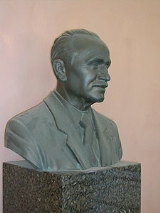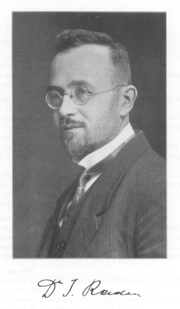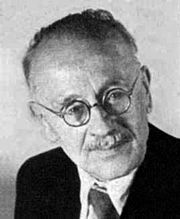
Johann Radon
Encyclopedia
Johann Karl August Radon (16 December 1887 – 25 May 1956) was an Austria
n mathematician
. His doctoral dissertation was on calculus of variations
(in 1910, at the University of Vienna
).
, Austria-Hungary
, now Děčín
, Czech Republic
. He received his doctoral degree at the University of Vienna
in 1910. He spent the winter semester 1910/11 at the University of Göttingen, then he was an assistant at the Deutsche Technische Hochschule Brünn (Brno
), and from 1912 to 1919 at the Technical University of Vienna. In 1913/14, he passed his habilitation
at the University of Vienna. Due to his near-sightedness, he was exempt from the draft during wartime.
 In 1919, he was called to become Professor extraordinarius at the newly founded University of Hamburg
In 1919, he was called to become Professor extraordinarius at the newly founded University of Hamburg
; in 1922, he became Professor ordinarius at the University of Greifswald, and in 1925 at the University of Erlangen. Then he was Ordinarius
at the University of Breslau from 1928 to 1945.
After a short stay at the University of Innsbruck he became Ordinarius at the Institute of Mathematics of the University of Vienna
on 1 October 1946. In 1954/55, he was rector of the University of Vienna.
In 1939, Radon became corresponding member of the Austrian Academy of Sciences
, and in 1947, he became a member. From 1952 to 1956, he was Secretary of the Class of Mathematics and Science of this Academy. From 1948 to 1950, he was president of the Austrian Mathematical Society.
Johann Radon married Maria Rigele, a secondary school teacher, in 1916. They had three sons who died young or very young. Their daughter Brigitte, born in 1924, obtained a Ph.D. in mathematics at the University of Innsbruck and married the Austrian mathematician Erich Bukovics in 1950. Brigitte lives in Vienna.
Radon, as Curt C. Christian described him in 1987 at the occasion of the unveiling of his brass bust at the University of Vienna
, was a friendly, good-natured man, highly esteemed by students and colleagues alike, a noble personality. He did make the impression of a quiet scholar, but he was also sociable and willing to celebrate. He loved music, and he played music with friends at home, being an excellent violinist himself, and a good singer. His love for classical literature lasted through all his life.
In 2003, the Austrian Academy of Sciences
founded an Institute for Computational and Applied Mathematics and named it after Johann Radon (see External link below).
 Radon is known for a number of lasting contributions, including:
Radon is known for a number of lasting contributions, including:
Austria
Austria , officially the Republic of Austria , is a landlocked country of roughly 8.4 million people in Central Europe. It is bordered by the Czech Republic and Germany to the north, Slovakia and Hungary to the east, Slovenia and Italy to the south, and Switzerland and Liechtenstein to the...
n mathematician
Mathematician
A mathematician is a person whose primary area of study is the field of mathematics. Mathematicians are concerned with quantity, structure, space, and change....
. His doctoral dissertation was on calculus of variations
Calculus of variations
Calculus of variations is a field of mathematics that deals with extremizing functionals, as opposed to ordinary calculus which deals with functions. A functional is usually a mapping from a set of functions to the real numbers. Functionals are often formed as definite integrals involving unknown...
(in 1910, at the University of Vienna
University of Vienna
The University of Vienna is a public university located in Vienna, Austria. It was founded by Duke Rudolph IV in 1365 and is the oldest university in the German-speaking world...
).
Life
Radon was born in Tetschen, BohemiaBohemia
Bohemia is a historical region in central Europe, occupying the western two-thirds of the traditional Czech Lands. It is located in the contemporary Czech Republic with its capital in Prague...
, Austria-Hungary
Austria-Hungary
Austria-Hungary , more formally known as the Kingdoms and Lands Represented in the Imperial Council and the Lands of the Holy Hungarian Crown of Saint Stephen, was a constitutional monarchic union between the crowns of the Austrian Empire and the Kingdom of Hungary in...
, now Děčín
Decín
Děčín is a town in the Ústí nad Labem Region in the north of the Czech Republic. It is the largest town and administrative seat of the Děčín District.-Geography:...
, Czech Republic
Czech Republic
The Czech Republic is a landlocked country in Central Europe. The country is bordered by Poland to the northeast, Slovakia to the east, Austria to the south, and Germany to the west and northwest....
. He received his doctoral degree at the University of Vienna
University of Vienna
The University of Vienna is a public university located in Vienna, Austria. It was founded by Duke Rudolph IV in 1365 and is the oldest university in the German-speaking world...
in 1910. He spent the winter semester 1910/11 at the University of Göttingen, then he was an assistant at the Deutsche Technische Hochschule Brünn (Brno
Brno
Brno by population and area is the second largest city in the Czech Republic, the largest Moravian city, and the historical capital city of the Margraviate of Moravia. Brno is the administrative centre of the South Moravian Region where it forms a separate district Brno-City District...
), and from 1912 to 1919 at the Technical University of Vienna. In 1913/14, he passed his habilitation
Habilitation
Habilitation is the highest academic qualification a scholar can achieve by his or her own pursuit in several European and Asian countries. Earned after obtaining a research doctorate, such as a PhD, habilitation requires the candidate to write a professorial thesis based on independent...
at the University of Vienna. Due to his near-sightedness, he was exempt from the draft during wartime.

University of Hamburg
The University of Hamburg is a university in Hamburg, Germany. It was founded on 28 March 1919 by Wilhelm Stern and others. It grew out of the previous Allgemeines Vorlesungswesen and the Kolonialinstitut as well as the Akademisches Gymnasium. There are around 38,000 students as of the start of...
; in 1922, he became Professor ordinarius at the University of Greifswald, and in 1925 at the University of Erlangen. Then he was Ordinarius
Professor
A professor is a scholarly teacher; the precise meaning of the term varies by country. Literally, professor derives from Latin as a "person who professes" being usually an expert in arts or sciences; a teacher of high rank...
at the University of Breslau from 1928 to 1945.
After a short stay at the University of Innsbruck he became Ordinarius at the Institute of Mathematics of the University of Vienna
University of Vienna
The University of Vienna is a public university located in Vienna, Austria. It was founded by Duke Rudolph IV in 1365 and is the oldest university in the German-speaking world...
on 1 October 1946. In 1954/55, he was rector of the University of Vienna.
In 1939, Radon became corresponding member of the Austrian Academy of Sciences
Austrian Academy of Sciences
The Austrian Academy of Sciences is a legal entity under the special protection of the Federal Republic of Austria. According to the statutes of the Academy its mission is to promote the sciences and humanities in every respect and in every field, particularly in fundamental research...
, and in 1947, he became a member. From 1952 to 1956, he was Secretary of the Class of Mathematics and Science of this Academy. From 1948 to 1950, he was president of the Austrian Mathematical Society.
Johann Radon married Maria Rigele, a secondary school teacher, in 1916. They had three sons who died young or very young. Their daughter Brigitte, born in 1924, obtained a Ph.D. in mathematics at the University of Innsbruck and married the Austrian mathematician Erich Bukovics in 1950. Brigitte lives in Vienna.
Radon, as Curt C. Christian described him in 1987 at the occasion of the unveiling of his brass bust at the University of Vienna
University of Vienna
The University of Vienna is a public university located in Vienna, Austria. It was founded by Duke Rudolph IV in 1365 and is the oldest university in the German-speaking world...
, was a friendly, good-natured man, highly esteemed by students and colleagues alike, a noble personality. He did make the impression of a quiet scholar, but he was also sociable and willing to celebrate. He loved music, and he played music with friends at home, being an excellent violinist himself, and a good singer. His love for classical literature lasted through all his life.
In 2003, the Austrian Academy of Sciences
Austrian Academy of Sciences
The Austrian Academy of Sciences is a legal entity under the special protection of the Federal Republic of Austria. According to the statutes of the Academy its mission is to promote the sciences and humanities in every respect and in every field, particularly in fundamental research...
founded an Institute for Computational and Applied Mathematics and named it after Johann Radon (see External link below).
Achievements

- his part in the Radon–Nikodym theoremRadon–Nikodym theoremIn mathematics, the Radon–Nikodym theorem is a result in measure theory that states that, given a measurable space , if a σ-finite measure ν on is absolutely continuous with respect to a σ-finite measure μ on , then there is a measurable function f on X and taking values in [0,∞), such that\nu =...
; - the Radon measureRadon measureIn mathematics , a Radon measure, named after Johann Radon, is a measure on the σ-algebra of Borel sets of a Hausdorff topological space X that is locally finite and inner regular.-Motivation:...
concept of measureMeasure (mathematics)In mathematical analysis, a measure on a set is a systematic way to assign to each suitable subset a number, intuitively interpreted as the size of the subset. In this sense, a measure is a generalization of the concepts of length, area, and volume...
as linear functionalLinear functionalIn linear algebra, a linear functional or linear form is a linear map from a vector space to its field of scalars. In Rn, if vectors are represented as column vectors, then linear functionals are represented as row vectors, and their action on vectors is given by the dot product, or the...
; - the Radon transformRadon transformthumb|right|Radon transform of the [[indicator function]] of two squares shown in the image below. Lighter regions indicate larger function values. Black indicates zero.thumb|right|Original function is equal to one on the white region and zero on the dark region....
, in integral geometryIntegral geometryIn mathematics, integral geometry is the theory of measures on a geometrical space invariant under the symmetry group of that space. In more recent times, the meaning has been broadened to include a view of invariant transformations from the space of functions on one geometrical space to the...
, based on integration over hyperplaneHyperplaneA hyperplane is a concept in geometry. It is a generalization of the plane into a different number of dimensions.A hyperplane of an n-dimensional space is a flat subset with dimension n − 1...
s — with application to tomographyTomographyTomography refers to imaging by sections or sectioning, through the use of any kind of penetrating wave. A device used in tomography is called a tomograph, while the image produced is a tomogram. The method is used in radiology, archaeology, biology, geophysics, oceanography, materials science,...
for scannerScannerScanner may refer to:* WikiScanner, a tool that provides a searchable database of anonymous Wikipedia edits* A personality type described by self-help author Barbara Sher-Technology:* Scanner , for searching for and receiving radio broadcasts...
s (see tomographic reconstructionTomographic reconstructionThe mathematical basis for tomographic imaging was laid down by Johann Radon. It is applied in computed tomography to obtain cross-sectional images of patients...
); - Radon's theoremRadon's theoremIn geometry, Radon's theorem on convex sets, named after Johann Radon, states that any set of d + 2 points in Rd can be partitioned into two sets whose convex hulls intersect...
, that d + 2 points in d dimensions may always be partitioned into two subsets with intersecting convex hullConvex hullIn mathematics, the convex hull or convex envelope for a set of points X in a real vector space V is the minimal convex set containing X....
s - the Radon-Hurwitz numbers.
- He is possibly the first to make use of the so called Radon-Riesz property.

